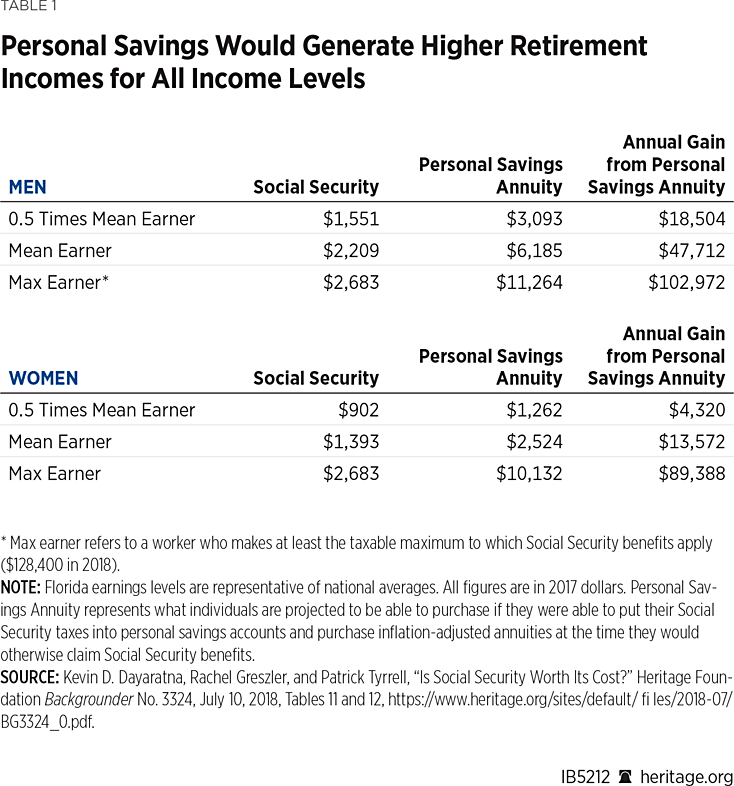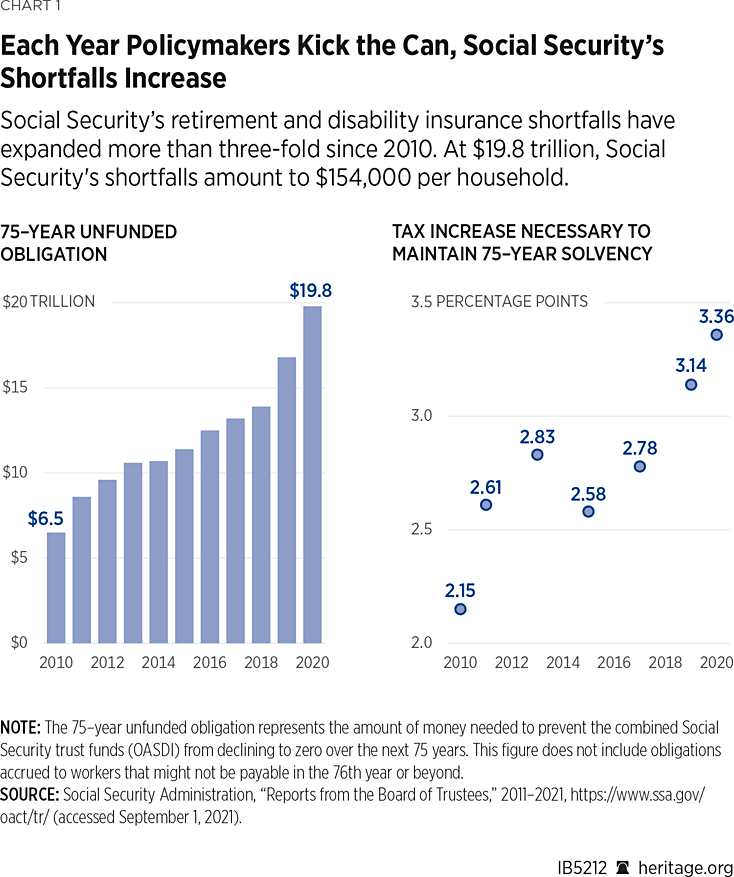This year’s Social Security Trustees report may provide the most compelling case for Social Security reform yet. A massive, $3.0 trillion increase in the combined Social Security and Disability Insurance (DI) programs’ unfunded obligations since just last year, and an expedited date of insolvency, indicate that everyone except the most elderly Americans will likely be affected by Social Security’s shortfalls.REF
Social Security reform is inevitable, but the impact of those reforms on individual workers, families, and the economy will depend on the direction of those reforms. If policymakers choose to make the program larger, with benefit increases and tax hikes, individuals will work less and save less, resulting in lower lifetime incomes and a smaller economy. If policymakers choose to make the program smaller and provide better-targeted benefits, individuals could keep more of their earnings and accumulate greater savings, resulting in higher lifetime incomes and a bigger economy.
Following are seven things that Americans should know about the Social Security Trustees’ 2021 report, and why it is crucial that policymakers act now to put Social Security’s two programs on a path toward solvency.
1. Social Security’s Retirement Program Is Projected to Be Insolvent in 2033. Absent legislation to address Social Security’s shortfalls, Social Security’s Old-Age and Survivors Insurance (OASI) benefits would need to be cut by 24 percent beginning in 2033.REF That means that anyone currently 50 or younger (those born in in 1971 or later) will not receive a single benefit equal to what Social Security’s formula currently provides. Moreover, tens of millions of retirees receiving Social Security benefits in 2033 will also be subject to 24 percent benefit cuts. If policymakers decide to raise taxes to keep the program solvent, it will burden all current and future workers, and it will also result in a smaller economy for everyone.
2. Social Security Has $19.8 Trillion in Unfunded Obligations. One figure that the Trustees provide each year is Social Security’s 75-year unfunded obligations for its combined retirement and disability insurance programs (OASDI). This figure represents the present value of the two programs’ costs minus their revenues over the next 75 years. At $19.8 trillion in 2020, the Social Security and DI programs’ unfunded obligation amounts to $154,000 for every household in the U.S. That is more than a typical household spends in five years on housing, groceries, gas, and clothing combined.REF
3. Social Security Has Now Been in the Red for More Than a Decade. Last year marked the 11th straight year that Social Security has been in the red, with the program paying out $96 billion more in benefits than it collected in payroll taxes. The only reason why the program is still considered solvent is that it is cashing in on IOUs that were previously issued to the program in exchange for using some of the payroll taxes that most people think are being set aside to fund their future benefits to finance other government spending. Cashing in those IOUs requires the Treasury to issue more publicly held debt.
4. Social Security Is Not a Good Deal for Current and Future Workers. With every dollar that workers pay in Social Security taxes immediately sent out the door to fund current retirees’ benefits, the program strips workers of the opportunity to earn a positive rate of return on their money. The effects of these lost earnings compound over time, creating a raw deal for current and younger workers. A Heritage Foundation analysis found that if a median earner who makes about $60,000 per year were allowed to keep and invest his Social Security taxes in a conservative mix of stocks and bonds, he would have three times as much retirement income—nearly $48,000 more per year than Social Security can provide.REF Even workers making less than $20,000 per year would have far more money in retirement if they were able to keep and save their Social Security taxes.REF

5. The Costs of Congressional Inaction Are Exponential. Each year that policymakers ignore Social Security’s shortfalls results in ever-higher costs and consequences for workers and retirees. Between just 2010 and 2020, Social Security’s combined retirement and disability programs’ unfunded obligations tripled, from $6.5 trillion to $19.8 trillion, and the size of immediate tax increases needed to maintain the programs’ solvency jumped from a 2.15 percentage-point increase to a 3.36 percentage-point increase. A 15.76 percent payroll tax, compared to the current 12.4 percent, would mean a $7,880 social security tax bill for someone making $50,000 per year. Not only would those taxes mean lower incomes during workers’ careers, but also lower incomes in retirement. A Heritage Foundation analysis found that even if politicians coupled tax increases with higher benefits, workers across all income levels would be worse off.REF

6. COVID-19 Is Not the Cause of Social Security’s Shortfalls. Despite high unemployment and the fact that $873 billion worth of generous federal unemployment benefits were not subject to payroll taxes, Social Security’s payroll tax revenues still increased by 6.3 percent in 2020. The Trustees’ report does note that the COVID-19 pandemic led to lower assumptions on productivity and output, delays in births and immigration, and an increase in mortality rates, the combination of which will have a negative impact on the program’s long-term finances, and contributed to the one-year-earlier projected insolvency date for Social Security’s retirement program (in 2033 instead of 2034). But Social Security was headed toward insolvency long before the COVID-19 pandemic.
7. Trustees’ Harsh Projections May Be Optimistic. In addition to the Social Security Trustees, the Congressional Budget Office (CBO) provides projections on Social Security’s finances. The CBO projects that Social Security will run out of funds to pay scheduled benefits beginning in 2032, at which point benefits would have to be cut by 25 percent.REF If policymakers were to decide to limit benefit cuts only to new beneficiaries after 2032 (protecting existing retirees), benefits would have to be reduced by 45 percent to maintain the program’s long-term solvency.REF
Since the need for Social Security reform is undeniable, the question is: How best to reform the program? If Social Security were carrying out its purpose well, providing a good deal to workers and retirees, and aiding economic growth, it might make sense to preserve the program primarily through tax increases.
But the reality is that Social Security is failing to keep many elderly and disabled people out of poverty while providing the largest payments to people with the highest incomes, and it is stripping workers of the opportunity to earn positive returns on their money. Social Security also creates winners and losers, not only across generations, but by way of life expectancy. For example, life expectancy is 10 years shorter for men in the bottom income quartile than for those in the top income quartile, and five years shorter for women in the bottom quartile than for women in the top quartile.REF Moreover, life expectancy at birth is about 3.5 years less for black Americans than for whites,REF and one of five black men will die between the ages of 45 and 65, having paid tens of thousands, if not hundreds of thousands, of dollars in Social Security taxes and receiving little or nothing in return for them or their families.REF
Social Security’s unchecked growth also weighs on workers and the economy. The program started as a 2 percent tax, promised never to take more than 6 percent, now consumes 12.4 percent of workers’ paychecks, and requires 15.76 percent to remain solvent. Analysis from the University of Pennsylvania’s Penn Wharton budget model projected that a smaller and better-targeted Social Security program would result in an economy that is 7.3 percent, or $1.6 trillion, largerREF than an expanded Social Security program.REF That translates into $10,740 more in annual income per household across the U.S.REF
Heritage Foundation analysts have proposed five solutions that would create a Social Security program with higher incomes and more opportunities for all Americans.REF Congress should:
- Gradually shift Social Security to a flat benefit. Social Security was not intended to be an income-replacement program, but to prevent poverty in old age; and yet, it provides the largest benefits to the highest-income people with the least need. By very gradually shifting Social Security toward a universal, anti-poverty benefit, increasing benefits for low-income earners and reducing them for middle-income and upper-income earners until everyone receives the same amount, Social Security could be made solvent and everyone could eventually pay significantly less in Social Security taxes.
- Update Social Security’s eligibility age and index it to life expectancy. When Social Security first began, the average life expectancy was only 61 years, meaning that the typical worker would not even receive Social Security benefits.REF Today, life expectancy has increased by 17 years, and the typical worker receives benefits for nearly two decades. Improved health and work capacity means that the average individual can work longer than before.
- Use a more accurate inflation index. The current inflation measure used by the Social Security Administration, the Consumer Price Index for Urban Wage Earners and Clerical Workers (CPI-W), is based on prices paid by less than a third of the population, and it fails to account for how people respond to changes in prices. There is bipartisan agreement among many policymakers and economists that the chained CPI is a more accurate index, and thus it should replace the outdated and inaccurate CPI-W.REF
- Let workers opt out of Social Security’s earnings test. Social Security’s misunderstood earnings test is perceived by workers as a 50 percent tax on their earnings, which results in those subject to the earnings test working and earning less than they otherwise would.REF Policymakers should end this paternalistic and economically detrimental policy and let workers choose whether they want to pay the tax in exchange for higher future benefits.
- Give workers an ownership option in Social Security. Individuals have no legal claim to their scheduled Social Security benefits, as Congress can change or take them away at any time.REF Workers should have the choice of contributing all of their payroll taxes to Social Security and receiving whatever benefit the program can provide when they retire, or of putting a portion of their taxes into their own personal account that would increase in value over time and could be used to purchase an annuity like Social Security provides, from which to withdraw funds as needed during retirement, or to pass on as an inheritance to family members.REF
According to The Heritage Foundation’s Social Security model, these changes would not only solve Social Security’s shortfalls, they would also allow a roughly 25 percent reduction in Social Security’s tax rate, allowing all Americans to keep more of their earnings to save and spend as they see fit for them and their families. The sooner that policymakers act to prevent Social Security’s insolvency, and to improve the program’s efficacy, the lower the costs and consequences will be for everyone.
Rachel Greszler is Research Fellow in Economics, Budget, and Entitlements in the Grover M. Hermann Center for the Federal Budget, of the Institute for Economic Freedom, at The Heritage Foundation.




